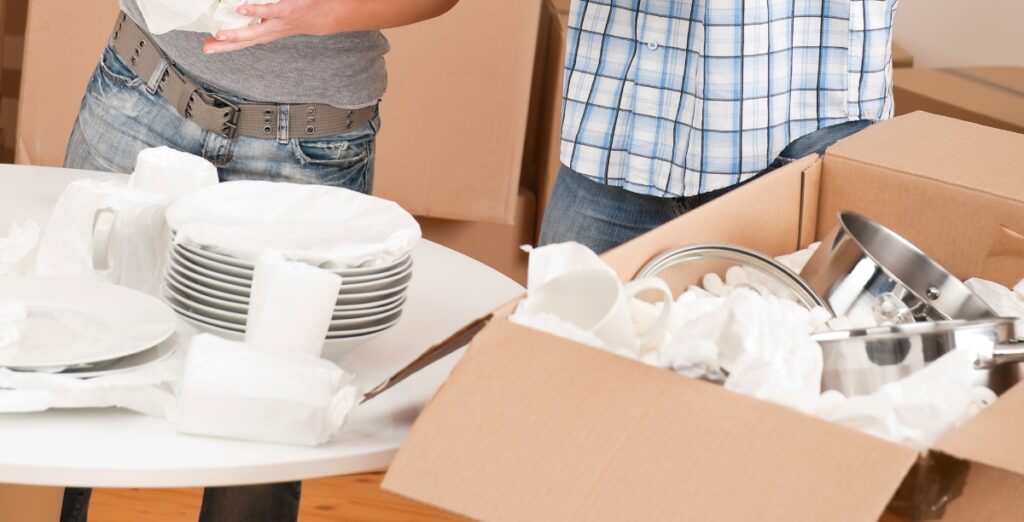In this guide, we’ll walk you through essential kitchen packing techniques that will make your move easier, ensuring your kitchen items are well-protected and that you’re able to unpack and set up your new kitchen with minimal hassle.
Table of Contents
ToggleWhy Kitchen Packing Requires Special Attention
The kitchen is arguably the most complex room to pack because it contains a variety of items, each requiring different packing techniques. Unlike clothing or books, kitchenware and appliances are often fragile, heavy, or oddly shaped, making them prone to damage during a move. A successful kitchen packing process needs to take into account:
- Fragility: Glassware, ceramics, and fragile dishes need to be protected with sufficient padding.
- Weight: Large pots, pans, and appliances are heavy, and it’s important to pack them in a way that avoids overloading boxes.
- Sharpness: Knives and other sharp kitchen tools need to be packed carefully to prevent injury during the move.
- Space efficiency: Kitchenware is often irregularly shaped, so it’s important to maximize space in boxes while ensuring items don’t shift and get damaged.
With the right packing materials and techniques, you can ensure that your kitchenware stays intact and is easy to organize once you reach your new home.
Step-by-Step Guide to Packing Your Kitchen
1. Gather Your Packing Materials
Before you start packing, gather all the necessary packing materials. Having everything you need on hand will make the process smoother and more efficient. The essential materials for packing kitchenware include:
- Sturdy cardboard boxes: Make sure to have a variety of box sizes, including small boxes for heavy items like cookware and larger boxes for lighter items such as plates and bowls.
- Bubble wrap: Great for fragile items like glassware and delicate china. It provides cushioning to prevent breakage.
- Packing paper: Useful for wrapping fragile items and filling gaps inside boxes.
- Packing tape: Strong tape to seal boxes securely.
- Foam padding or foam sheets: Ideal for protecting items with nonstick coatings and preventing scratches on metal pots and pans.
- Plastic stretch wrap: Can be used to wrap bundles of utensils, group items together, or secure fragile pieces.
- Dish pack boxes: These specially designed boxes come with dividers to protect plates and glasses during a move.
- Towels or old clothing: You can repurpose soft cloth materials to cushion fragile items or line boxes for extra protection.
2. Start with Breakable Items
Start by wrapping your most fragile kitchenware items first, including glassware, dishes, and china. These items require extra care to avoid chipping, cracking, or breaking.
- Plates and Bowls: To pack plates, stack them vertically, similar to how they would be stacked in a cabinet. This minimizes pressure on individual plates and helps them absorb shocks better. Wrap each plate individually in packing paper or bubble wrap. Be sure to tape the paper or bubble wrap securely to avoid it unraveling during the move. For bowls, wrap them separately and stack them carefully in the box.
- Tip: Always use a dish pack box with dividers for added protection when packing plates and bowls. The dividers will help separate the items, reducing the chance of them shifting and breaking.
- Glassware and Stemware: Wine glasses, drinking glasses, and stemware are particularly prone to breakage due to their delicate nature. Wrap each piece in packing paper, then use bubble wrap to provide extra cushioning. When packing glasses, try to pack them upright in a box, similar to the way they are stored in a cabinet. Fill any empty spaces in the box with crumpled packing paper to prevent them from shifting.
- Tip: You can stuff glassware with packing paper or bubble wrap to help them maintain their shape and avoid damage.
3. Pack Cookware with Care
Cookware, such as pots, pans, and skillets, is often bulky and heavy, so it requires careful packing to prevent damage and ensure that boxes are not overloaded.
- Nonstick Cookware: Nonstick pans require extra care to prevent their surface from scratching or losing its coating. Wrap each piece in a soft cloth, foam sheet, or towel to cushion it. If you’re packing a stack of nonstick pans, be sure to place a layer of paper between each one to prevent friction that could cause scratches.
- Heavier Pots and Pans: When packing heavy items like cast iron skillets or large stockpots, make sure to pack them in smaller boxes to avoid overloading. Use foam padding or bubble wrap to fill the interior of the pots and prevent them from moving around in the box. Place heavy pots at the bottom of the box and lighter items on top.
- Tip: Use plastic stretch wrap to bundle smaller pots or pans together, making them easier to handle and less likely to shift during the move.
4. Wrap Knives and Sharp Tools
Knives and other sharp kitchen tools require special attention to ensure they don’t cause injury or damage to other items. Here’s how to pack them safely:
- Wrap Each Knife Individually: Wrap each knife in a sheet of packing paper, then cover the blade with bubble wrap or a towel. Be sure to tape the kitchen wrapping securely, but don’t tape directly to the blade, as this could damage the knife. For added protection, you can also use knife blade protectors, which are available at many moving supply stores.
- Bundle Utensils: For smaller utensils like forks, spoons, and tongs, bundle them together in a cloth towel or with plastic wrap. If you’re packing a large set of cutlery, place it in a box and fill the empty space with packing paper to prevent shifting.
5. Pack Appliances Carefully
Small kitchen appliances like blenders, coffee makers, and food processors are often awkwardly shaped and delicate, so they need extra attention.
- Wrap Large Appliances: For larger appliances such as stand mixers or blenders, wrap them in moving blankets or foam padding to protect them from impact. Be sure to remove any detachable parts (such as blender jars or beaters) and pack them separately to avoid breaking.
- Use Original Boxes: If you still have the original boxes for your appliances, these are ideal for packing. The boxes are designed to fit the appliances snugly and offer built-in protection with molded foam or other protective materials.
6. Maximize Box Space and Label Everything
Once everything is wrapped and ready for packing, it’s time to load it into boxes. Here are some key tips:
- Fill Gaps: Use packing paper, towels, or even dish towels to fill any empty spaces in the boxes. This prevents items from shifting around and helps absorb any potential impact.
- Avoid Overpacking: While it’s tempting to fill boxes to the brim, overpacking can cause boxes to break or items to get damaged. When packing, ensure that the box is full, but not too heavy. If a box is too heavy, it may be difficult to lift and more likely to break.
- Label Everything: Label each box with its contents and mark boxes that contain fragile items. This will help you and the movers know what’s inside and will ensure that the boxes are handled with care during the move. Write “Fragile” in large, bold letters and indicate which side of the box should be kept upright.
7. Unload and Set Up Efficiently
When you arrive at your new home, unpack the kitchen boxes carefully and start with the essential items like dishes, cutlery, and cookware. Set up your kitchen in an organized way to save time and effort in the long run.
- Prioritize Essentials: Unpack the essentials first, such as your pots, pans, and utensils, to ensure you can start using your kitchen right away.
- Check for Breakages: Inspect all fragile items for breakage or damage, especially if they were packed with extra care. If something is damaged, make a note of it for insurance purposes.
Conclusion
Packing a kitchen for a move doesn’t have to be stressful if you approach it with the right materials and techniques. By taking the time to properly wrap fragile items, pack cookware securely, and organize your kitchenware efficiently, you can minimize the risk of damage and make unpacking a breeze. With the essential wrapping techniques outlined in this guide, you’ll be ready to tackle your kitchen packing with confidence, ensuring that everything arrives at your new home safe and sound.



